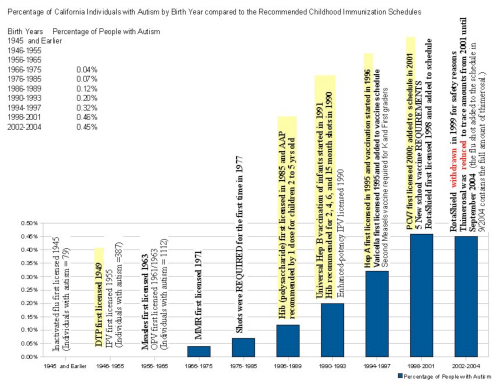Correlation Between Increases in Autism Prevalence and Introduction of New Vaccines
Safeminds.org
Autism prevalence increased rapidly in the late 1980s. The epidemic increased simultaneously in states across the United States, indicating that U.S. children were exposed to toxins in a consistent manner across the entire country. Due to the high adherence amongst the states to the CDC-recommended vaccination schedule, vaccines typically introduce a new exposure to children simultaneously throughout the country.
The phased introduction of the Hib vaccine in 1985-1990 and the universal introduction of the HepB vaccine in 1991 correspond closely with the epidemic increase in autism prevalence. A history of the issue with thimerosal-containing vaccines can be found here.
The graph below shows a correlation between introduction of these mercury-containing vaccines (thimerosal is the name for the ethylmercury preservative in vaccines) and the rise in autism prevalence.
View larger image of this graph
The graph below from The Vaccines Risks vs. Benefits Blog shows a correlation to autism prevalence increases and introduction of new vaccines. Interestingly, it shows there was no increase in the autism percentage rate from 2002-2004 when no aluminum-containing or live-virus vaccines were added to the recommended childhood immunization schedule. This website has information on when aluminum-containing vaccines were introduced and the biological plausibility of aluminum injected in vaccines being a contributing factor to autism.

View larger image of this graph
This short presentation of slides demonstrates that the exposure to aluminum in vaccines has increased as the mercury exposure has reduced, and that the exposure to mercury in vaccines can still be over half the 1999 levels due to the flu vaccine. See aluminum and mercury in vaccines through 2007 Ayoub.pdf






















